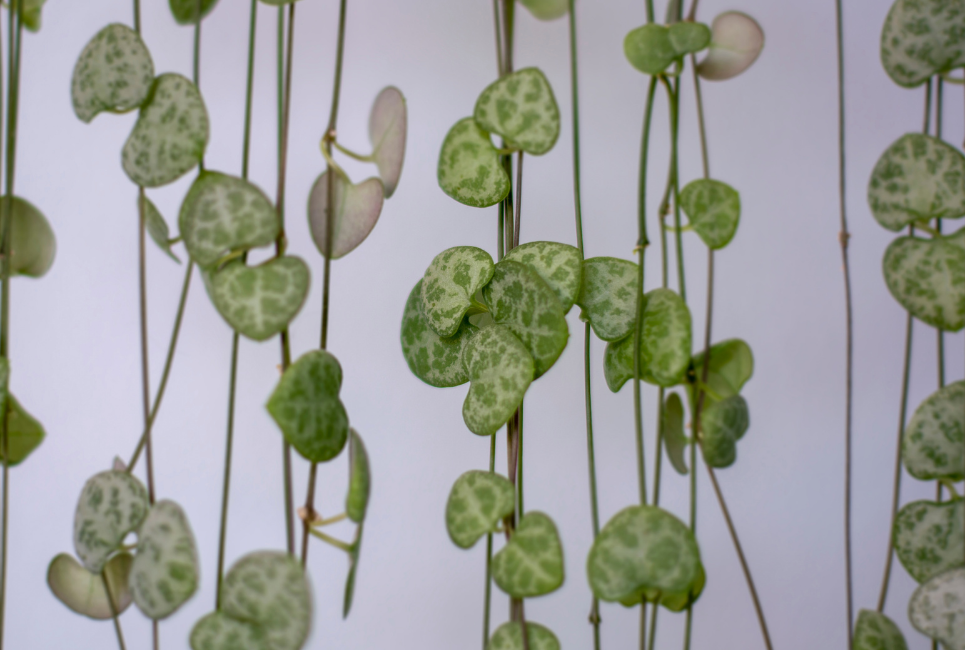This is a delicate evergreen trailing succulent vine that is alluring in its beauty and its uncomplicated nature. It is also known as Hearts Entangled, Chain of Hearts, Rosary Vine, and Sweetheart Vine.
How to Identify String of Hearts
This plant is easy to identify from its long trailing stems that grow heart-shaped leaves that are variegated green.
Where Does String of Hearts Grow
This plant is native to the southern tip of African and can be found in South Africa, Swaziland, and Zimbabwe.
Uses of String of Hearts
Since String of Hearts can grow vines that are up to 13 feet long, it is an excellent plant to set in a hanging container or on a balcony edge. Its vines can be allowed to dangle over the container or entwine a trellis.
How to Grow String of Hearts from Seed
This plant is easy to grow from seeds. It may take a long time to get the seeds growing, but it is quite a fun process to try. If your game to get your hands dirty and to test your ‘green thumb’ here are the steps for propagating a String of Hearts plant from seed.
- Allow the seed pods to harden and open.
- Collect the seeds before they fall or fly away and place them in a breathable bag (a tea bag will work perfectly).
- Select and purchase a seed tray.
- Select and purchase seedling potting mix.
- Fill the tray with the potting mix
- Sow the seeds in the potting mix.
- Place the tray in a warm area with bright but indirect sunlight.
- Keep the potting mix moist but not soggy.
- Expect to see tiny sprouts in about a month’s time.
- The new sprouts can be repotted in a different container.

String of Hearts Growing Conditions
This plant needs an environment that is similar to most other types of succulents. It needs plenty of heat and indirect sunlight, as well as soil that will drain off excess water.
When to Plant String of Hearts
It is best to plant String of Hearts during the warm and sunny months of spring and summer. If planted in cool and cloudy months, the seeds may not germinate.
How to Plant String of Hearts
When planting String of Hearts, it is a good idea to keep these tips in mind.
- Use a container that has drainage holes or select a ground plot that will drain water
- Use potting soil that is well-draining
- Use gravel at the bottom of the container or ground plot for extra drainage (optional)
- Before planting a String of Hearts in the ground, make sure you live in an area where it can grow outside all year round. This plant can grow in USDA Hardiness Zones 11 and 12, so make sure this corresponds with the area where you live.
- Also, keep in mind that String of Hearts can grow quickly and take over a yard quickly, so don’t plant it somewhere outside where it can get away from you.
Once you have selected where to plant your String of Hearts and the proper potting soil, follow these steps to plant it:
- Place some gravel at the bottom of the container or the ground plot selected
- Place the potting soil on top of the gravel
- Make a small hole in the potting soil
- Set the plant into the hole
- Cover the roots with potting soil and make sure the plant is secure in its new home
- Water the plant until the soil is moist but not soggy
String of Hearts Water Requirements
Just like most other succulents, String of Hearts is susceptible to root rot, so it is best to allow them to dry out completely between watering sessions. The best way to water one of these that is in a container is to use the soak and dry method. The steps for doing this are as follows:
- Fill a tray or a sink with a few inches of water.
- Set the plant container in the tray making sure that the water is not so deep that it will run over the top of the container. The point of watering in this way is so that the roots will soak up the water and the leaves will not get wet.
- Let the plant soak in the water for fifteen minutes. This will allow the root system to soak up water from the bottom of the container.
- Take the plant container out of the water.
- Place the plant container in a spot where the excess water can drain from the hole in the bottom.
- Repeat this only when the soil around the plant is dry.
If you feel uncertain about watering your String of Hearts, why not try a plant water app like Waterbot?

String of Hearts Sun Requirements
This plant needs a lot of bright, indirect sunlight. Full and direct sunlight will be too much for its delicate leaves to handle. If kept indoors, it will grow best when set directly in a north-facing or an east-facing window or a few feet from a southern-facing or western-facing window. If you are uncertain about the lighting in your indoor living space and how it will affect your plants, use this guide to help you measure the amount of light the plants will be getting in any room.
Best String of Hearts Fertilizer
Don’t worry about fertilizing String of Hearts during the cold months; it will only need to be fertilized during the warm months of spring and summer. Use a liquid house plant fertilizer, such as Miracle-Gro Indoor Plant Food every three to four weeks.
Best String of Hearts Companion Plantings
It is nice to have a variety of plants to grow and display together. Since String of Hearts is an undemanding plant, it is a good idea to find a companion plant that is also undemanding. If you are interested in getting one or a few more plants for your garden or home, try one of these options next to your String of Hearts plant.
String of Turtles
This is an adorable succulent from the rainforests of Brazil. Its tiny, turtle shell-shaped leaves will complement the heart-shaped leaves of a String of Hearts plant. This could be a plant companionship made for the ages.

Pros:
- Does not require fertilizer
- Grows well in indirect sunlight or with a grow light
- Can handle moisture better than most other types of succulents
- It is a small plant that is perfect for decorating living spaces
Cons:
- It is toxic to animals
- Its temperature needs are different from String of Hearts (it requires cool humidity)
- Its soil needs are different from String of Hearts (it requires acidic soil that is rich in peat)
String of Pearls
This is another trailing succulent that looks beautiful in hanging planters. Just image heart-shaped leaves set next to pearl-shaped leaves; it will be stunning. Your hanging planters will be the talk of the town with other gardeners.

Pros:
- It needs bright, indirect sunlight, just like String of Hearts
- It needs light fertilizing during spring and summer, just like String of Hearts
- It needs well-draining soil, just like String of Hearts
- It needs the same amount of water as String of Hearts
- It needs the same range of temperatures as String of Hearts
Cons:
- It is susceptible to root rot
- It is toxic to animals and humans
String of Dolphins
This little plant looks like a pod of dolphins jumping around. It is very playful and would make a great companion for a String of Hearts plant.

Pros:
- It is easy to grow and care for
- It does not require regular fertilizing
- It can grow in medium amounts of sunlight or under a grow light
- It is drought-tolerant
Cons:
- It can easily be overwatered
- It is not frost or cold tolerant
- It is toxic to humans and animals
String of Hearts Diseases and Common Problems
When properly watered, fertilized, and placed in the right amount of sunlight and the right type of soil, String of Hearts has very few problems. If, however, it doesn’t get the proper care, it can face the following:
- Aphids
- Mealybugs
- Root rot
String of Hearts Treatments and Maintenance
The best way to treat a String of Hearts plant is to deal with its issues as soon as possible. Take some time to learn what common problems this plant faces and how you can deal with them quickly.
Aphids
These little insects are usually green but can come in a variety of colors. Their most prominent feature is that they are fat and teardrop-shaped. If you notice these insects on your plant, you can use a mixture of soapy water and vegetable oil to spray the infested areas. Neem oil can also be applied to the leaves of the plant to help remove the insects and prevent them from returning.

Mealybugs
If you notice white fluff growing on your plant, you may have a mealybug infestation. To rid your plant of these pests, apply rubbing alcohol to any places on the plant where you see the white fluff or the actual insects. There is also the option of spraying the plant with a solution of diluted dish soap and water.
Mealybugs can also be hiding in the roots of the plant. If this is the case with your Pig’s Ear succulent, it will require that you remove the plant from its container, shake off the soil, wash the roots with diluted alcohol or soapy water, allow the plant to dry, and then, replant it in new, fresh soil.
Note: Ridding your plant of mealybugs may take a few treatments over several weeks.
Root Rot
When String of Hearts gets too much water it can cause root rot and this will eventually kill the plant. The best way to prevent root rot is to learn how to properly water the plant. But, if your plant is already dealing with the negative effects of overwatering (mushy leaves, yellowed leaves, transparent leaves, leaves that are falling out) then you will need to treat it immediately so that it has any chance of surviving.
Follow these steps to treat a String of Hearts plant that has root rot:
Dry Out the Plant
- Stop watering the plant immediately and set the plant’s container in a place that will allow the soil to drain off any excess water.
- If the soil is unable to drain, you will need to remove the plant from the soggy soil, let it dry out for a few days, and then, replant it in dry soil.

Remove the Rotten Parts
Trim off any areas of the plant that are rotting, then allow the plant to callous for a few days. Without letting it callous, the chances of the succulent surviving are very slim.
Add Sulfur to the Root System
This technique should be done after the plant has been trimmed of all its rotted areas and allowed to callous. It will require that you dust a little sulfur on its root system to help prevent the spread of microbes.
String of Hearts Repotting Instructions
This type of succulent is easy to propagate and replant. In fact, it is so easy, that you may want to do it regularly so that you can grow more of them in different areas of your lawn and garden or gift them to loved ones. If you decide to do this, here are the steps.
- Select a container or a plot of ground that is well-draining.
- Select a spot that will also get plenty of bright but indirect sunlight.
- Select potting soil that is well-draining.
- Wash your hands.
- Cut off a stem that has visible nodes.
- Set the stem in a glass of water for a few weeks to allow it to grow a new root system. Or, alternately, set the stem on top of potting soil and let the root system grow into the soil.
- Once the stem that has been kept in a glass of water has grown some roots it can be planted in the selected potting soil and container or garden plot (do not plant it any deeper than the length of the roots).
- Use a spray bottle to mist the soil with some water.
- Be sure the plant gets partial to full sun.
- Once the plant is established, it can be cared for as a mature succulent.

Where to Buy String of Hearts Seeds Online
If you plan to purchase some String of Hearts seeds, try one of these online shops:
Where to Buy String of Hearts Plants Online
If you plan to purchase some String of Hearts plants, try one of these online shops:
FAQs
Question: Is String of Hearts Toxic?
Answer: No, this is not known to be a toxic plant.
Question: Can String of Hearts be Pruned?
Answer: Yes, this plant should be pruned regularly to prevent it from taking over a garden space. Also, pruning it regularly will keep it looking healthy and beautiful.
Question: Does String of Hearts Produce Blooms?
Answer: Yes, this plant can produce magenta-colored flowers when given the proper care. Proper care includes watering and fertilizing techniques, as well as, adequate heat and sunlight.
Concluding Thoughts
String of Hearts is certainly a wonderful plant that will easily entwine your heart with its dainty beauty and carefree spirit. If you need a plant that is easy to grow and easy on the eyes, then consider adding a String of Hearts to your garden space. You won’t regret letting one of these beauties leave a trail of loveliness in your life.
Research Citations
Read more guides below:
- Senecio Radicans (String of Bananas Succulents): A Complete Care and Growth Guide
- Agave Blue Glow: All You Need To Know In Care and Growth
- Ceropegia Woodii Variegata (Variegated String of Hearts) How To Grow Them Lush
- Lophocereus Marginatus (Mexican Fence Post Cactus) - January 10, 2022
- Best Cactus Fertilizer Guide - January 9, 2022
- Selenicereus Grandiflorus (Queen of the Night) - January 3, 2022


